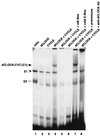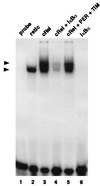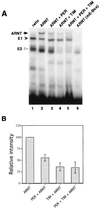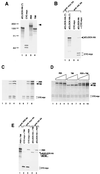PER and TIM inhibit the DNA binding activity of a Drosophila CLOCK-CYC/dBMAL1 heterodimer without disrupting formation of the heterodimer: a basis for circadian transcription
- PMID: 10409723
- PMCID: PMC84375
- DOI: 10.1128/MCB.19.8.5316
PER and TIM inhibit the DNA binding activity of a Drosophila CLOCK-CYC/dBMAL1 heterodimer without disrupting formation of the heterodimer: a basis for circadian transcription
Abstract
The Drosophila CLOCK (dCLOCK) and CYCLE (CYC) (also referred to as dBMAL1) proteins are members of the basic helix-loop-helix PAS (PER-ARNT-SIM) superfamily of transcription factors and are required for high-level expression of the circadian clock genes period (per) and timeless (tim). Several lines of evidence indicate that PER, TIM, or a PER-TIM heterodimer somehow inhibit the transcriptional activity of a putative dCLOCK-CYC complex, generating a negative-feedback loop that is a core element of the Drosophila circadian oscillator. In this report we show that PER and/or TIM inhibits the binding of a dCLOCK-CYC heterodimer to an E-box-containing DNA fragment that is present in the 5' nontranscribed region of per and acts as a circadian enhancer element. Surprisingly, inhibition of this DNA binding activity by PER, TIM, or both is not accompanied by disruption of the association between dCLOCK and CYC. The results suggest that the interaction of PER, TIM, or both with the dCLOCK-CYC heterodimer induces a conformational change or masks protein regions in the heterodimer, leading to a reduction in DNA binding activity. Together with other findings, our results strongly suggest that daily cycles in the association of PER and TIM with the dCLOCK-CYC complex probably contribute to rhythmic expression of per and tim.
Figures





Similar articles
-
dCLOCK is present in limiting amounts and likely mediates daily interactions between the dCLOCK-CYC transcription factor and the PER-TIM complex.J Neurosci. 2000 Mar 1;20(5):1746-53. doi: 10.1523/JNEUROSCI.20-05-01746.2000. J Neurosci. 2000. PMID: 10684876 Free PMC article.
-
Closing the circadian loop: CLOCK-induced transcription of its own inhibitors per and tim.Science. 1998 Jun 5;280(5369):1599-603. doi: 10.1126/science.280.5369.1599. Science. 1998. PMID: 9616122
-
Regulation of the cycling of timeless (tim) RNA.J Neurobiol. 2001 Jun 5;47(3):161-75. doi: 10.1002/neu.1024. J Neurobiol. 2001. PMID: 11333398
-
Circadian clocks--from genes to complex behaviour.Reprod Nutr Dev. 1999 May-Jun;39(3):277-94. doi: 10.1051/rnd:19990301. Reprod Nutr Dev. 1999. PMID: 10420431 Review.
-
Insights into the molecular mechanisms of temperature compensation from the Drosophila period and timeless mutants.Chronobiol Int. 1997 Sep;14(5):455-68. doi: 10.3109/07420529709001468. Chronobiol Int. 1997. PMID: 9298282 Review.
Cited by
-
dCLOCK is present in limiting amounts and likely mediates daily interactions between the dCLOCK-CYC transcription factor and the PER-TIM complex.J Neurosci. 2000 Mar 1;20(5):1746-53. doi: 10.1523/JNEUROSCI.20-05-01746.2000. J Neurosci. 2000. PMID: 10684876 Free PMC article.
-
Drosophila doubletime mutations which either shorten or lengthen the period of circadian rhythms decrease the protein kinase activity of casein kinase I.Mol Cell Biol. 2004 Jan;24(2):886-98. doi: 10.1128/MCB.24.2.886-898.2004. Mol Cell Biol. 2004. PMID: 14701759 Free PMC article.
-
Small-molecule inhibitors of the Myc oncoprotein.Biochim Biophys Acta. 2015 May;1849(5):525-43. doi: 10.1016/j.bbagrm.2014.03.005. Epub 2014 Mar 19. Biochim Biophys Acta. 2015. PMID: 24657798 Free PMC article. Review.
-
Circadian and Genetic Modulation of Visually-Guided Navigation in Drosophila Larvae.Sci Rep. 2020 Feb 17;10(1):2752. doi: 10.1038/s41598-020-59614-y. Sci Rep. 2020. PMID: 32066794 Free PMC article.
-
Coordination between Differentially Regulated Circadian Clocks Generates Rhythmic Behavior.Cold Spring Harb Perspect Biol. 2018 Jul 2;10(7):a033589. doi: 10.1101/cshperspect.a033589. Cold Spring Harb Perspect Biol. 2018. PMID: 28893860 Free PMC article. Review.
References
-
- Allada R, White N E, So W V, Hall J C, Rosbash M. A mutant Drosophila homolog of mammalian Clock disrupts circadian rhythms and transcription of period and timeless. Cell. 1998;93:791–804. - PubMed
-
- Baldwin A S., Jr The NF-kappa B and I kappa B proteins: new discoveries and insights. Annu Rev Immunol. 1996;14:649–683. - PubMed
-
- Chen Y, Hunter-Ensor M, Schotland P, Sehgal A. Alterations of per RNA in noncoding regions affect periodicity of circadian behavioral rhythms. J Biol Rhythms. 1998;13:364–379. - PubMed
Publication types
MeSH terms
Substances
LinkOut - more resources
Full Text Sources
Other Literature Sources
Molecular Biology Databases
